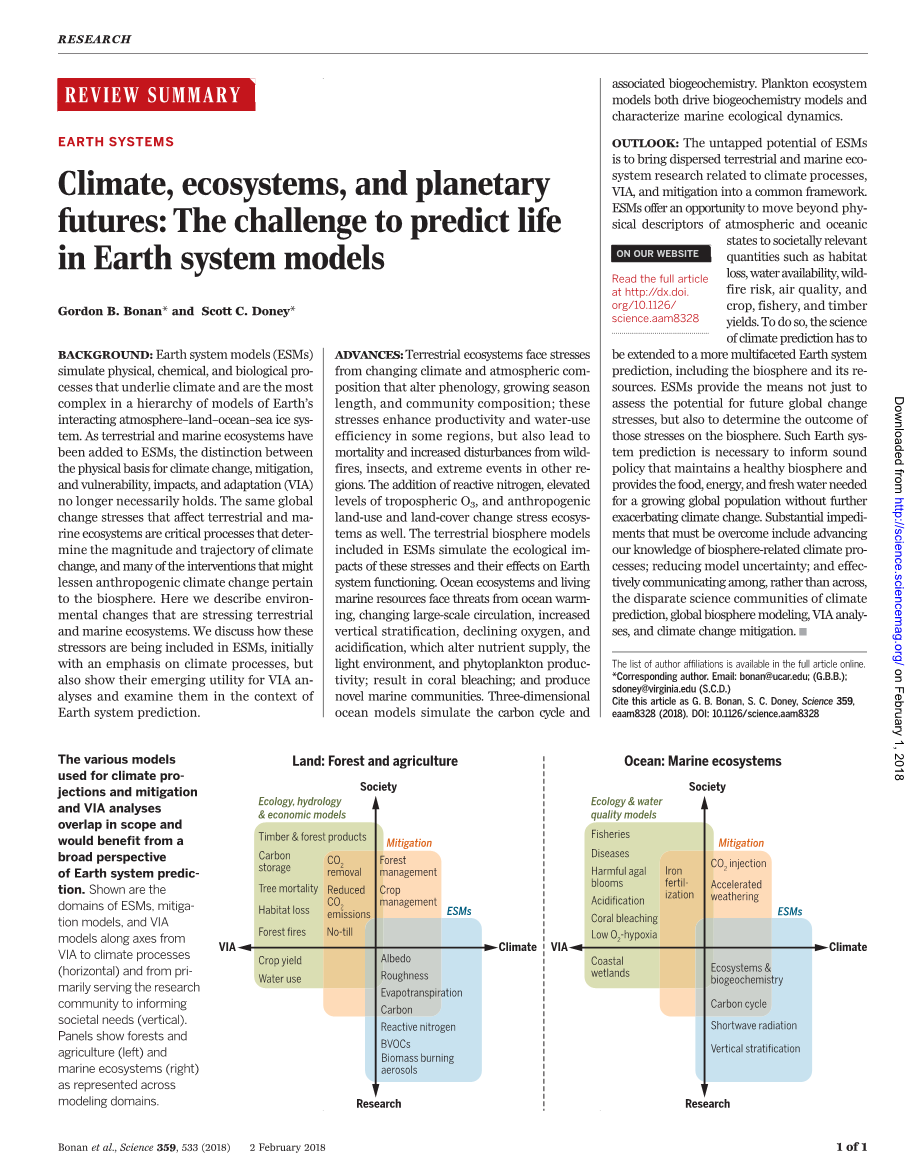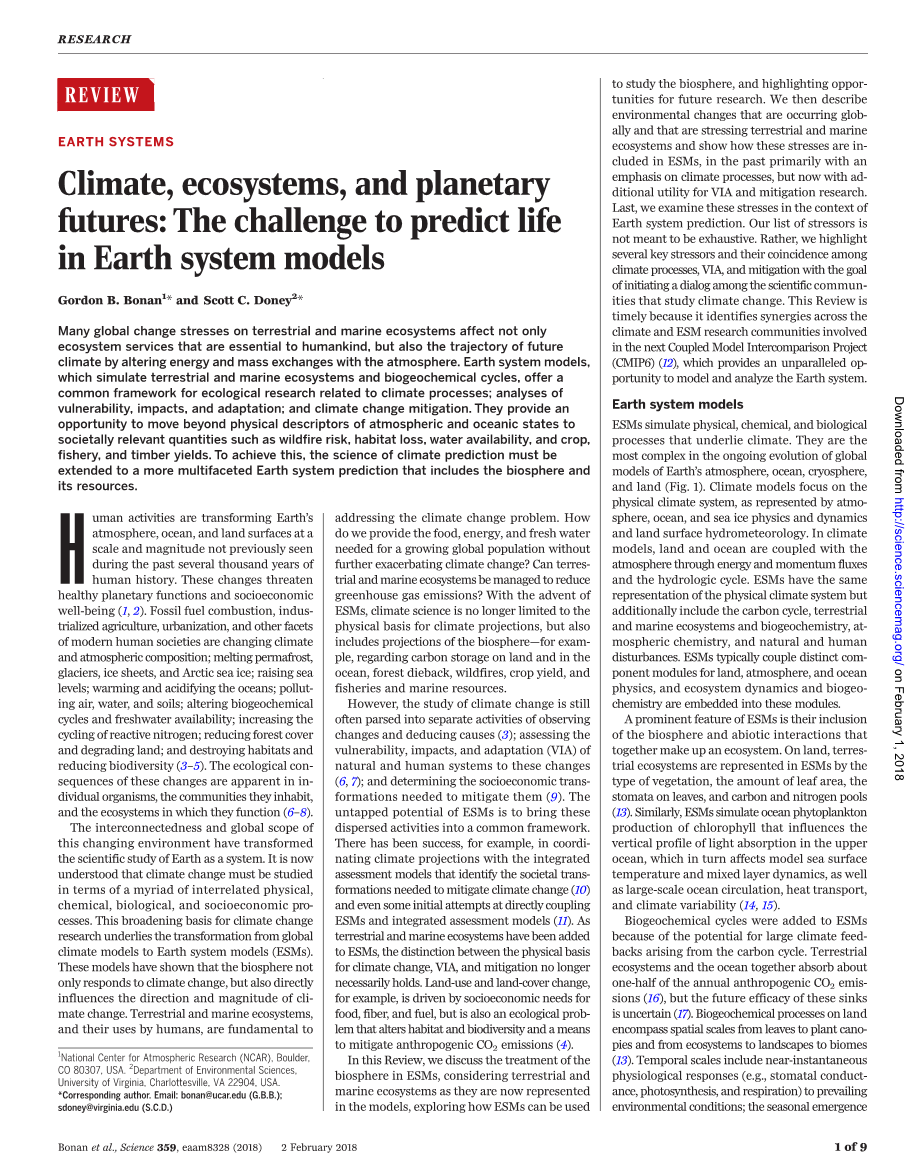气候,生态系统以及星球的未来:在地球系统模式中预测生活的挑战外文翻译资料
2022-12-27 15:35:42


英语原文共 11 页,剩余内容已隐藏,支付完成后下载完整资料
|
Climate, ecosystems, and planetary futures: The challenge to predict life in Earth system models |
气候,生态系统以及星球的未来:在地球系统模式中预测生活的挑战 |
|
BACKGROUND |
背景 |
|
Earth system models (ESMs) simulate physical, chemical, and biological processes that underlie climate and are the most complex in a hierarchy of models of Earthrsquo;s interacting atmosphere–land–ocean–sea ice system. |
地球系统模型模拟的物理,化学和生物过程,是气候变化的基础,也是陆表-地-气-海洋-海冰相互作用系统模型层次结构中最为复杂的一环。 |
|
As terrestrial and marine ecosystems have been added to ESMs, the distinction between the physical basis for climate change, mitigation, and vulnerability, impacts, and adaptation(VIA) no longer necessarily holds. |
随着陆地和海洋生态系统被加入到地球系统模式中以后,气候的变化与缓和,脆弱性、影响和适应性(VIA),这些响应的物理基础之间的区别就不再存在了。 |
|
The same global change stresses that affect terrestrial and marine ecosystems are critical processes that determine the magnitude and trajectory of climate change, and many of the interventions that might lessen anthropogenic climate change pertain to the biosphere. |
影响陆地和海洋生态系统的关键过程是相同的全球变化强迫,这会决定气候变化大小和轨迹。许多可能会减少人为气候变化的干预措施都与生物圈有关。 |
|
Here we describe environmental changes that are stressing terrestrial and marine ecosystems. |
在这里我们描述正在强迫陆地和海洋生态系统的环境变化。 |
|
We discuss how these stressors are being included in ESMs, initially with an emphasis on climate processes, but also show their emerging utility for VIA analyses and examine them in the context of Earth system prediction. |
我们讨论这些强迫因素如何被囊括进地球系统模型里面,起初是强调其气候过程,同时也展示其对于VIA分析的新作用以及在地球系统预测的环境下检测这些强迫。 |
|
Advances |
进步 |
|
Terrestrial ecosystems face stresses from changing climate and atmospheric composition that alter phenology, growing season length, and community composition; these stresses enhance productivity and water use efficiency in some regions, but also lead to mortality and increased disturbances from wild fires, insects, and extreme events in other regions. |
陆地生态系统面临的强迫来自于气候变化以及大气成分的变化,这些变化改变了物候、生长季的长度和群落组成。这些强迫提高了某些地区的生产力和水分利用效率,但也导致了死亡率和其他地区野火、虫害和极端事件发生的概率的提高。 |
|
The addition of reactive nitrogen, elevated levels of tropospheric O3, and anthropogenic land-use and land-cover change stress ecosystems as well. |
活性氮的增加、对流层臭氧的水平升高以及人为的土地利用和土地覆盖变化也对生态系统造成了影响。 |
|
The terrestrial biosphere models included in ESMs simulate the ecological impacts of these stresses and their effects on Earth system functioning. |
包含在地球系统模型中的陆地生物圈模型模拟了这些强迫的生态影响及其对地球系统功能的影响。 |
|
Ocean ecosystems and living marine resources face threats from ocean warming, changing large scale circulation, increased vertical stratification, declining oxygen, and acidification, which alter nutrient supply, the light environment, and phytoplankton productivity; result in coral bleaching; and produce novel marine communities. |
海洋生态系统和海洋生物资源面临着海洋变暖、大规模循环变化、垂直分层增加、氧气减少和酸化的威胁,这些变化导致了营养供应、光照环境和浮游植物的生产力的改变;导致珊瑚白化;并产生新的海洋生物群落形式。 |
|
Three-dimensional ocean models simulate the carbon cycle and associated biogeochemistry. |
三维的海洋模型模拟了碳循环和相关的生物地球化学过程 |
|
Plankton ecosystem models both drive biogeochemistry models and characterize marine ecological dynamics. |
浮游生物生态系统模型既驱动生物地球化学模型,又描述了海洋生态动力学特征。 |
|
OUTLOOK |
展望: |
|
The untapped potential of ESMs is to bring dispersed terrestrial and marine ecosystem research related to climate processes, VIA, and mitigation into a common framework. |
地球系统模型还未曾被开发的潜力是将与气候过程有关的陆地和海洋生态系统研究,VIA和减缓,纳入一个共同的框架中去 |
|
ESMs offer an opportunity to move beyond physical descriptors of atmospheric and oceanic states to societally relevant quantities such as habitat loss, water availability, wild fire risk, air quality, and crop, fishery, and timber yields. |
地球系统模型提供了一个超越对大气和海洋状态进行物理层面描述的机会,使其与诸如栖息地丧失、水源可用性、野外火灾风险、空气质量、作物、渔业和木材产量等社会相关的计量联系在一起。 |
|
To do so, the science of climate prediction has to be extended to a more multifaceted Earth system prediction, including the biosphere and its resources. |
要做到这一点,气候预测必须被扩展上升到一个更多层面的地球系统预测,包括生物圈和生物资源。 |
|
ESMs provide the means not just to assess the potential for future global change stresses, but also to determine the outcome of those stresses on the biosphere. |
地球系统模型不仅提供了评估未来全球变化强迫的可能性的手段,而且还将决定这些强迫对生物圈的影响结果。 |
|
Such Earth system prediction is necessary to inform sound policy that maintains a healthy biosphere and provides the food, energy, and fresh water needed for a growing global population without further exacerbating climate change. |
这样的地球系统预测是有必要的,以制定健全的政策,来维持一个健康的生物圈,并为不断增长的全球人口提供所需的食物、能源和淡水,同时确保不会进一步加剧气候变化。 |
|
Substantial impediments that must be overcome include advancing our knowledge of biosphere related climate processes; reducing model uncertainty; and effectively communicating among, rather than across, the disparate science communities of climate prediction, global biosphere modeling, VIA analyses, and climate change mitigation. |
在这之中我们必须克服的重大阻碍包括,增进我们对于生物圈相关气候过程的认识,减少模型的不确定度;以及在与气候预测,全球生态圈模型,VIA分析以及气候变化减缓有关的不同科学团体之中有效的沟通交流,而非直接的跨领域。 |
|
The various models used for climate projections and mitigation and VIA analyses overlap in scope and would benefit from a broad perspective of Earth system prediction. |
用于气候预测和减缓以及VIA分析的各种模型,相互重叠,并将从地球系统预测的宽广层面受益。 |
|
剩余内容已隐藏,支付完成后下载完整资料 资料编号:[24676],资料为PDF文档或Word文档,PDF文档可免费转换为Word |




